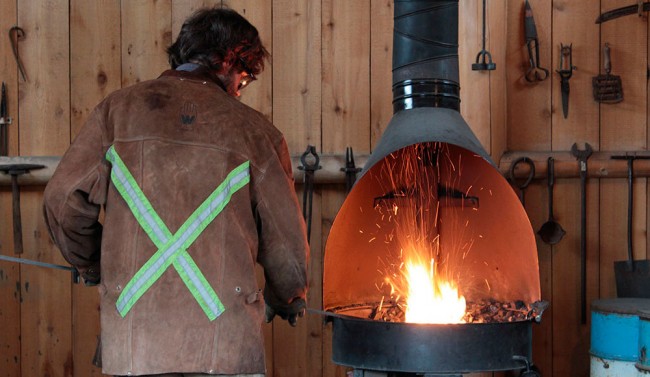
Photo Credit: Kelsey Wiebe
Forging Into the Past: Camp worker re-ignites a family tradition in blacksmithing
“Hey, does that smithy work?” Curtis Hampton asked a summer student at Terrace’s Heritage Park Museum three years ago.
“What’s a smithy?” the hapless student replied.
As it turns out, a smithy is a blacksmith’s forge and, yes, it does work—as Hampton would prove over the next three years. The 26-year-old camp worker created a home for himself in the museum’s blacksmithing shop, which was constructed in 2009 to house master blacksmith Don Parmenter’s donated tool collection and only used a handful of times before Hampton’s work as an electrician and welder brought him to Kitimat.
A self-taught blacksmith who also dabbles in flint knapping and bow making, Hampton grew up on a small farm an hour from Kamloops. Being homeschooled allowed him to explore hobbies like blacksmithing. After moving to the Northwest, he at first stayed in a small, well-appointed room in camp featuring a brand-new television and a shared bathroom. Every time he left for a week turnaround, his room rotated; he’d leave his stuff at the front desk and move into a new room upon return.
“Camp life isn’t bad as long as you get out of it,” he says. “If you have hobbies that you can do, it makes it a lot more enjoyable and passes the time when you’re not working.”
He often fished or hiked after work and came to Terrace occasionally, hoping to buy something at the tackle shop or the health food store. Neither was ever open on Sundays, his single day off in the project’s early days, and eventually he made his way to Heritage Park Museum.
Most museum visitors spend an hour or so perusing the buildings. Hampton spent six hours and felt like he had barely scratched the surface. For weeks afterward, he interrogated museum staff about the origin of an old hand planer or the precise function of some strange-looking piece of machinery.
It didn’t take long for Hampton to ask to rent the smithy. The board of directors decided that if he would agree to follow safety rules and demonstrate his craft for tourists, he was welcome to use it for free. Some context: other historic sites pay qualified blacksmiths upwards of $35 an hour to do interpretive blacksmithing, when they can find them.
Thus began a fruitful partnership that lasted three years.
Chip off the anvil
Hampton honed his craft in the blacksmith’s shop, forging hooks, knives, ornaments and belt buckles out of scrap metal he sourced from the dump, the scrapyard and friends’ backyards. His favourite part about blacksmithing, he told staff, was “taking a raw piece of metal and turning it into something useful.” He began coming so frequently (every Sunday, every turnaround day, some evenings after work) that he was once caught sleeping in the shop so he could get an early start the next morning.
His co-workers at the Kitimat Modernization Project looked on Hampton with bemusement. He cajoled several into coming to help move heavy steel or learn to hammer basic pieces. Around camp, rumours about his blacksmithing circulated, as did his lengthy list of requests. His fellow camp workers jokingly labelled his toolbox “City Boy”—clearly a misnomer for the blacksmithing, flint knapping, bearded young man who could jerry-rig pretty much anything.
Hampton expanded the blacksmith’s shop by building a larger, portable forge, which allowed for larger projects, using donated steel from Kitimat Iron and A.J. Forsyth. He cobbled together his own toolset from blacksmiths who had retired or passed away, including well-known Terrace blacksmith Ted Johnston. He tracked down and learned from other locals, like Don Parmenter, Norm Hayduk, Adam Thomas and Marty Eisner, who trained as a farrier.
Although descended from a line of Scottish blacksmiths, the most recent was his fourth great-grandfather and Hampton feels like he is continuing an interrupted family tradition. He has infinite patience for the work and sometimes spends days heating up metal, hammering it until it begins to cool down and repeating the process, ad nauseam.
When the blacksmith shop’s coal stock ran out, Hampton tracked down an unmined coal seam on a turn-of-the-century map and drove to Telkwa to pickaxe it himself. The coal turned out to be sulphury, so he drove to Ridley Terminals in Prince Rupert, only to discover the coal terminal doesn’t sell to individuals. A kindly foreman took pity on Hampton and loaded up his bucket for free when he found out that Hampton was a volunteer blacksmith. Since then, the terminal has supplied the museum with smooth-burning coal.
Finding his place
As Hampton runs the forge, he pauses to explain to tourists what he’s doing. Blacksmithing shows people “how it could have been done in the past. It’s a more real and personal experience than just reading about it or watching a movie on the subject,” he says. The blacksmith’s shop was crucial to an early pioneer community, when settlers needed axes, saws, hammers, nails and horseshoes to clear land, transport, chop firewood and build houses.
“If there wasn’t a blacksmith, there couldn’t be a town,” Hampton reflects. “Blacksmiths were needed to make everything, even the tools and implements for the local dentist and doctor.”
During special events, a queue of onlookers peeks over the blacksmith shop’s half doors, drawn in by the fire, the clanging and the esoterism of the craft.
“It’s a dying art,” Hampton tells people curious about why anyone in an age of social media and iPads would spend days hammering red-hot steel. “I might as well keep it alive while I can.”
Is there a place for blacksmithing in today’s society? Hampton thinks so: “There’s still a demand for high-quality, hand-made tools and implements. A lot more people are trying to go back to simpler ways where certain tools and implements that they need cannot be made any other way.”
At Heritage Park Museum, Hampton found his niche. “I didn’t feel like I fit into the community before I started blacksmithing,” he reflects. Through the exploration of an ancient, dying trade, he found a way to integrate himself into the Northwest and pursue his own interests while assisting a museum. As the work at the Kitimat Modernization Project dwindled out, Hampton left town to find work elsewhere, following the migration of workers across the province—and the country—in search of well-paying industrial jobs.






